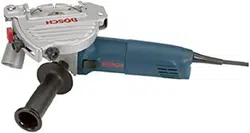Loading ...
Loading ...
Loading ...

Causes and Operator Prevention of
Kickback:
Kickback is a sudden reaction to a pinched,
bound or misaligned rotating wheel. The
wheel may stall and cause an uncontrolled
machine to back out of the kerf toward the
operator.
If an abrasive wheel or diamond wheel
becomes twisted, canted or misaligned in
the cut, the side of the wheel that is entering
into the material can dig into the top surface
of the material causing the wheel to climb
out or kickback out of the kerf.
Abrasive wheels may also shatter under
these conditions causing pieces or
fragments to strike or impale the operator
and bystanders. Kickback or shattered
wheels are the result of tool misuse and/or
incorrect operating procedures or conditions
and can be avoided by taking proper
precautions as given below:
Maintain a firm grip with both hands on
the machine handles and position your
body and arm to allow you to resist
kickback forces. The operator can control
kickback forces, if proper precautions are
taken.
When wheel is binding, or when
interrupting a cut for any reason, release
the trigger and hold the machine
motionless in the material until the wheel
comes to a complete stop. Never attempt
to remove the machine from the work
while the wheel is in motion or kickback
may occur. Investigate and take corrective
action to eliminate the cause of wheel
binding.
When restarting a machine in a
workpiece, center the wheel in the kerf
and check that the sides of the wheel are
not engaged into the material. If wheel is
binding, it may walk up or kickback from the
workpiece as the machine is restarted.
Wheel depth adjusting locking levers/nuts
must be tight and secure before making a
cut. If depth adjustment shifts while cutting,
it may cause binding and kickback. Using
the machine with an excessive depth of cut
setting increases loading on the unit and
susceptibility to twisting of the wheel in the
kerf. It also increases the surface area of the
wheel available for pinching under wheel
twisting conditions or misalignment.
Use extra caution when making a “Pocket
Cut” into existing walls or other blind
areas. The protruding wheel may cut
objects that can cause kickback.
Some dust created by
power sanding, sawing,
grinding, drilling, and other construction
activities contains chemicals known to
cause cancer, birth defects or other
reproductive harm. Some examples of
these chemicals are:
• Lead from lead-based paints,
• Crystalline silica from bricks and cement
and other masonry products, and
• Arsenic and chromium from chemically-
treated lumber.
Your risk from these exposures varies,
depending on how often you do this type of
work. To reduce your exposure to these
chemicals: work in a well ventilated area,
and work with approved safety equipment,
such as those dust masks that are specially
designed to filter out microscopic particles.
-5-
!
WARNING
Sound and Vibration Information
These values stated below were obtained by
laboratory testing in accordance with
Standard EN 50 144.
The typical sound pressure level is 89 dB (A).
The typical sound power level is 102 dB (A).
The typical weighted vibration is 1.8 m/s2.
Values measured in individual work places
may be higher than the declared values. The
actual exposure values and risk of harm
experienced by an individual user are unique
and depend upon the way the user works,
the workpiece and the workstation design,
as well as upon the exposure time and the
physical condition of the user.
Wear hearing protection.
Prolonged exposure to high
intensity noise can cause hearing loss.
Use thick cushioned
gloves and limit the
exposure time by taking frequent rest
periods. Vibration caused by the use of
power tools may be harmful to your hands
and arms.
!
WARNING
!
WARNING
BM 3609929818 3/03 3/10/03 8:42 AM Page 5
Loading ...
Loading ...
Loading ...
